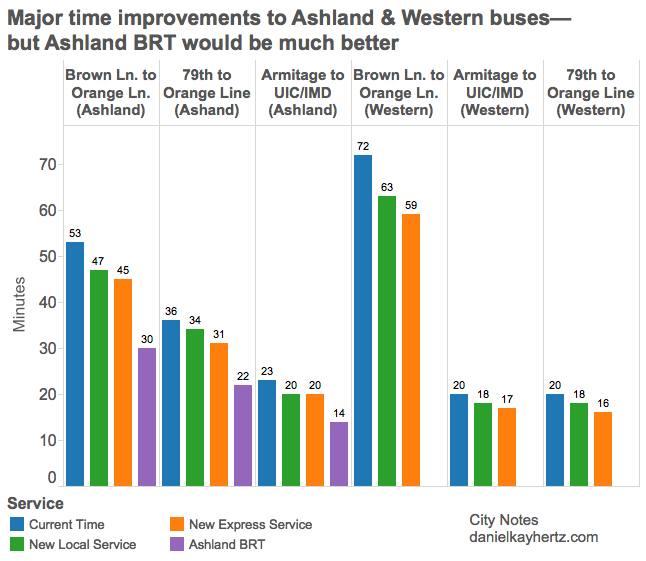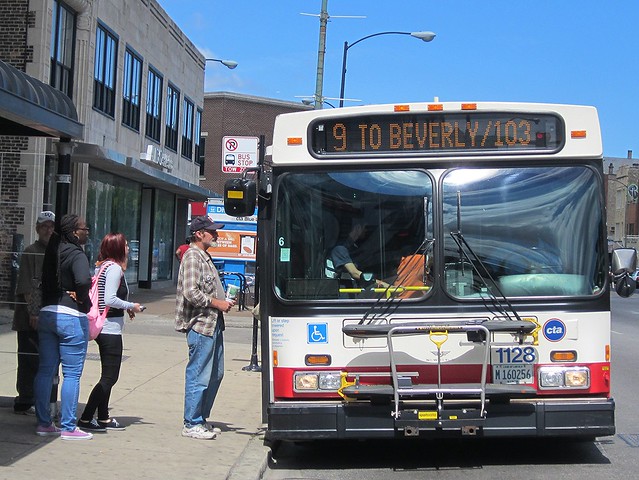Bus riders who take buses on Ashland and Western Avenues are getting faster, more reliable service. The Chicago Transit Authority is bringing back the old express bus routes on these streets, and they're also adding transit signal prioritization and cutting little-used stops on the local bus runs. While these are welcome improvements, the city should move forward with its plan for full-fledged bus rapid transit service on Ashland, which would be much faster than the express buses.
The X9 Ashland and X49 Western expresses bus routes, along with all other X routes and other service, were cut in 2010. The new express buses will make about half as many stops as the local buses, which provides a significant time savings. Later, the CTA and the Chicago Department of Transportation will add Transit Signal Priority. By extending stoplights turn green faster as a bus approaches, or extending the green, TSP helps keep riders from getting stuck at intersections.
The local buses on Ashland and Western will also be faster because the CTA is removing some stops where few people board or disembark, so that buses will stop approximately every one-quarter mile instead of every one-eighth mile. It then makes sense for riders to simply hop on the first bus that shows up at an express stop, rather than waiting for an express bus, because waiting for the express might cancel out any time savings from fewer stops.
Daniel Kay Hertz charted the projected travel time gains of the Ashland and Western service on his blog City Notes. He compared the CTA's estimates of the travel times for the current bus service, the new local service, the new express service, and the proposed Ashland bus rapid transit system. Hertz's chart makes it clear that while consolidating stops on the local buses will result in a significant time saving, the new express buses won't be that much faster than the new locals.

The CTA plan calls for the express buses to only run during rush hours as "supplementary service," but Hertz suggests an alternative. "If people are just getting on whatever the first bus is, then it may make more sense to make the express the basic service, and the local the supplementary." Of course, that might not be so popular with people whose local bus stop would see fewer buses per hour than the express buses.
Moreover, the CTA plans to maintain the current number of local buses. But Hertz says it would be ideal to have both types of buses operating all day, with twice as many express runs as locals.
Hertz is quick to note that, while the new expresses and faster locals will be an improvement, you can't beat BRT when it comes to speedy bus service. The city's Ashland plan calls for center-running buses with dedicated lanes, pre-paid, level boarding, multiple doors, plus other time-saving features. As you can see from the above chart, the Ashland BRT would dramatically shorten trip times compared to the new local and express buses.
The new local bus service is comparable to the "Modern Express Bus" proposal floated by the anti-BRT group the Ashland-Western Coalition. MEB would have had about 30 percent fewer stops than the current locals, but the times saving would have paled in comparison to BRT. "You can see in this chart just how much less convenient that [consolidated stop local] service is than BRT—on the order of 30-50% longer trip times," Hertz wrote.
When the return of the express bus service was originally announced back in August, the Sun-Times prematurely danced on the grave of the BRT plan, claiming that it seemed "all but dead." However, CDOT Commissioner Rebekah Scheinfeld has stated that these short-term improvements aren't a sign that the BRT plan is off the table.
![]()
Did you appreciate this post? Streetsblog Chicago is currently funded until April 2016. Consider making a donation through our PublicGood site to help ensure we can continue to publish next year.





